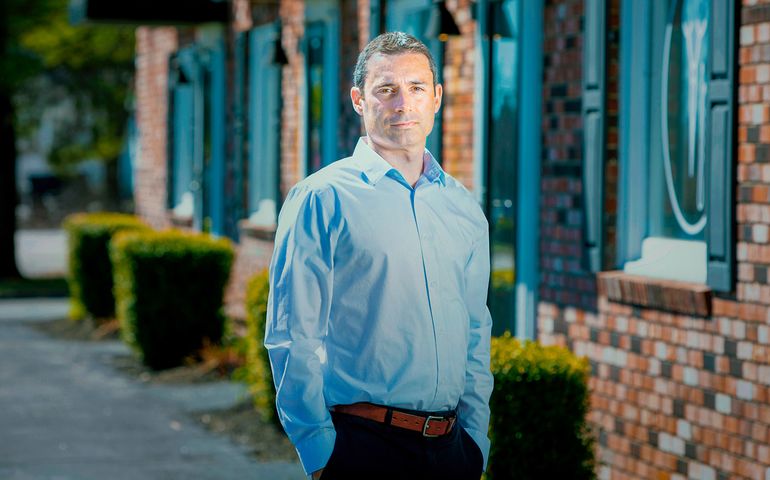
No exit: The pandemic is creating a tough year for succession planning
 Photo / Tim Greenway
Nate Bacon, owner of the structural engineering firm Base Design Group in Portland, began a formal transition planning process to ensure a line of succession as the business matured. The process was interrupted by the pandemic.
Photo / Tim Greenway
Nate Bacon, owner of the structural engineering firm Base Design Group in Portland, began a formal transition planning process to ensure a line of succession as the business matured. The process was interrupted by the pandemic.
Nate Bacon began contemplating a transition plan for his business almost as soon as he founded it.
It was 2011, not long after the 2008-09 recession. It was difficult to attract experienced talent for his small structural engineering firm, Base Design Group in Portland.
“We started by hiring graduate students and then grew at a slower pace from the bottom up,” he says.
As the firm evolved, Bacon wanted to provide a path for employee advancement to top leadership positions and, ultimately, partnerships. A year ago, he met with his firm’s accountant, David Jean at Altus Exit Strategies in Portland, to begin developing a conceptual plan. The next step was coming up with a formal execution strategy, beginning with an initial business valuation, a process begun earlier this year.
Then the pandemic hit and Bacon paused the planning process. Priorities changed as the firm, like all businesses now, tackles the daily challenges of operating in a drastically altered environment.
“What’s most important at the moment is dealing with the unique challenges that each new day brings as we all work together to get through these challenging times,” he says.
“When the time is right for our full team to return to the office, we can pick up on some of our more mid- and long-range goals. It’s not an issue of whether or not we are going to be here in two or three months or a year from now, although there is some uncertainty about what it might look like on the other side.
"What’s kept our plan from moving forward is prioritizing the needs of each passing day to ensure our business continues operating successfully until the day comes when we are all able to return to the office.”
Bacon’s circumstance isn’t unusual. Many business owners have put the planning process on hold.

“Everyone I know who was working on some form of succession plan — a sale of the business to employees, a transition to the next generation, a purchase of another business, a sale to an outside party, and an ESOP in the works — has put everything on hold,” says Jim Lyon of Summit 9 Consulting, a business coaching and consulting firm in Yarmouth.
“The reasons vary, but boil down to uncertainty. Too much uncertainty reduces the value of companies and reduces the willingness and ability to transfer leadership.”

Running out the clock
Transition plans — sometimes called succession or exit plans, depending on the goals and structure — are considered an important part of owning a business. It’s about ensuring business continuity once the owner or owners exit, while also achieving the departing owner’s goals.
Considerations when crafting a plan include the owner’s goals in transferring the business to others, and the structure of the transfer, perhaps as an outright sale or a gradual transfer of owner interest. Some advisors say the planning process should start when the business starts, as an integral and dynamic consideration that changes as the business evolves.
Yet many owners don’t think about it until they’re ready to retire, says Lyon.
“There are a handful of owners, even relatively young business owners, who start out thinking, ‘What will I do with this business when I’m done with it?’” Lyon says. “However, the majority of people don’t give it much thought until they reach a point where they think, ‘I’d like to be done in three to five years.' Often, three to five years can remain three to five years for a decade or longer because they never get a plan together.
"Owners struggle with exit plans because no one is holding them accountable to create one, it’s daunting to think about so they don’t know what to do, and deep down they aren’t convinced they want to exit. Owners tend to stay in limbo in their business until they discover something more interesting to do, and then they want to rush the process.”
Dynamic process
Jean, Bacon’s accountant, starts by helping owners identify their financial objectives.
“Through that discovery process, we get to understand their financial needs during retirement, what the business is worth, and what’s the best avenue for transition,” he says. “Is it a third-party sale, a transfer to the next generation, a sale to a management group or a private equity group, or perhaps an employee stock ownership plan? Through the discovery process, we help formulate a plan.”

Not having a plan can take a toll on the business, particularly if an owner’s departure is unexpected, says Jean. For a business with multiple owners, the departure of one can take place smoothly through a transfer of interest.
“It becomes a real problem if you’re a single owner,” he continues. “If something happens to you unexpectedly, what happens to the ownership of the company? Will it go to a spouse? Will it be a liquidation? Will it be up to the spouse or a general manager to put the company up for sale? At that point, it’s difficult to know what’s going to happen without knowing what the plan is. Often the spouse doesn’t want to operate the business. You might have key employees who don’t want the business either. Then it becomes s a fire sale and significantly reduces the value of the company, and you’re putting the company and employees at risk.”
The process can be emotional.
“A lot of owners have spent their lives building their business and it’s difficult for them to decide when and under what circumstances they’ll give up control,” says Nathaniel Putnam of Eaton Peabody’s Bangor office.
Succession planning always has a fairly significant element of uncertainty in it, says Gretchen Jones with Eaton Peabody’s Brunswick office. “I always tell clients that succession planning isn’t something you do once and then put on the shelf and leave it there. It should be a dynamic and ongoing process because things change all the time.”
Pressing pause
The pandemic is the very definition of that uncertainty.
Previously, the strong economy resulted in many business owners exiting because valuations were high and companies had the cash flow to buy out owners, says Jean.
Now, he says, “The uncertainty could delay a lot of folks who were planning to exit, maybe another year or two, until things normalize again.”
He adds, “To some extent this could affect the value of companies that had been in the process of putting together a plan. And it could impact the company’s ability to pay the parting owner. Right now, there’s a lot of wait and see.”
Clients are busy dealing with keeping their businesses going, says Hans Peterson, a partner at Rudman Winchell in Bangor.
“I think for most people, putting a moratorium on the planning process for six months isn’t that big a deal,” he says. “‘I want to have a business that I can sell to someone’ — that’s the concern.”
The pandemic will likely impact the planning process in the future, he says.
“People will ask questions they’ve never asked before,” he says. “It’s human nature to say, ‘If this happened once, it can happen again.’ We’re already seeing that in other contractual provisions.”
For example, the legal community is debating whether pandemics are covered under a contractual provision called the “force majeure clause,” which excuses performance obligations under certain circumstances.
“I think,” says Peterson, “it’s going to make people acquiring the business and the people selling the business ask the question, ‘What happens if there’s another stay-at-home order in the future? What happens if the business can’t operate because there’s an order that says it’s non-essential?’ I’m not sure anyone will completely scrap their old plan when we come back. But I think people will say, ‘There needs to be a discussion if this kind of thing happens again.’”














0 Comments